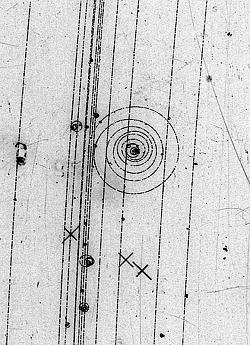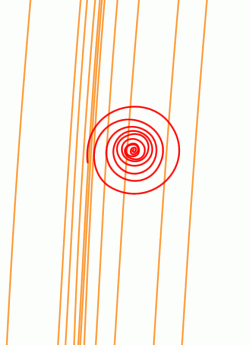

Pretty knock-on electron (delta-ray)
Picture from CERN 2-metre hydrogen bubble chamber exposed to a beam of negative
kaons (![]() ) with energy 4.2 GeV. This piece corresponds to about 70 cm in the
bubble chamber.
) with energy 4.2 GeV. This piece corresponds to about 70 cm in the
bubble chamber.
The 12 parallel lines are trails of bubbles – initiated by the ionization of hydrogen by the beam particles, which enter at the bottom of the picture.
Occasionally, by chance, a particle can give an electron ![]() more
energy than usual. In this case, instead of contributing to the normal string
of bubbles,
the
more energetic electron
more
energy than usual. In this case, instead of contributing to the normal string
of bubbles,
the
more energetic electron ![]() can
itself travel and produces its own trail of bubbles. Electrons (and also
anti-electrons, or positrons) are instantly
recognizable
in the bubble chamber because their tracks spiral; for more details, click
here. On this picture there is one spectacular electron spiral and a few
smaller ones.
can
itself travel and produces its own trail of bubbles. Electrons (and also
anti-electrons, or positrons) are instantly
recognizable
in the bubble chamber because their tracks spiral; for more details, click
here. On this picture there is one spectacular electron spiral and a few
smaller ones.
These spiralling knock-on electrons are helpful because they enable us to determine the direction of the magnetic field that is causing the tracks to curve.
As far as the particle physicist is concerned, this picture would not be useful because not one of the beam tracks has collided with a proton.
Questions:
1. How many beam tracks enter the bubble chamber?
2. Try to identify some electrons. What is the direction of the magnetic field?
3. Why do electrons leave curly tracks?
4. Why are all the electron tracks not of the same size?
Answers:
1. 12
2. Into the screen/paper
3. Because accelerated charges lose energy by emitting electromagnetic
radiation.
Electrons, being by far the lightest charged particles, respond (accelerate)
more to forces exerted on them (both electric from the nuclei, and magnetic from
applied field); a=F/m.
4. Chance - it depends on how close the moving charged particle gets, and on
how fast it is moving.